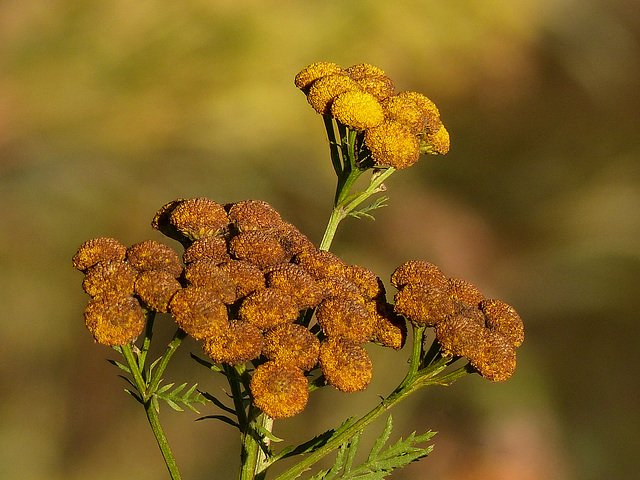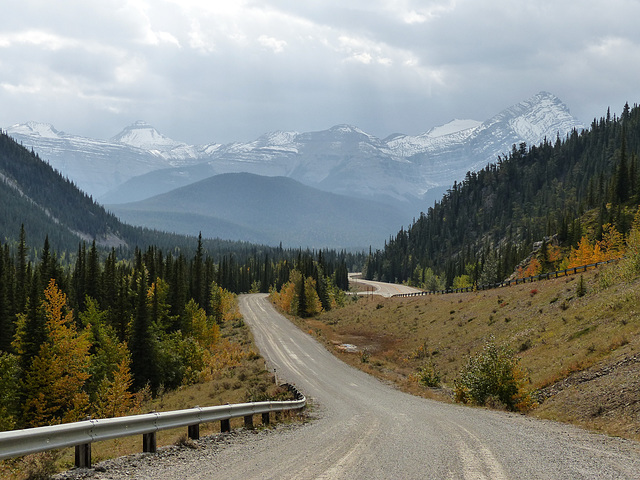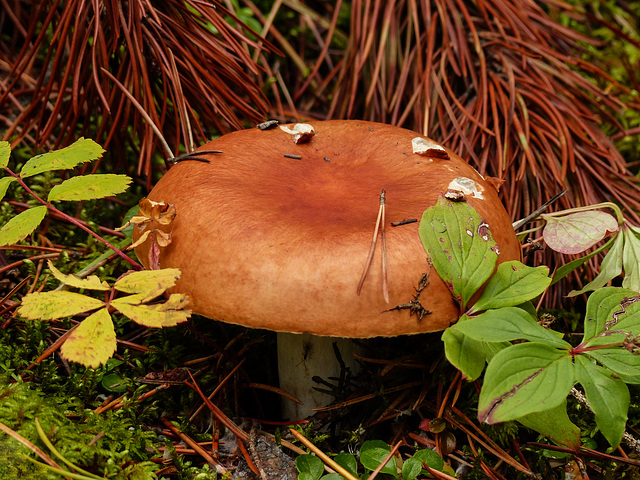
Explore, Flickr
02 May 2011
Owl butterfly
These are large, rather fancy butterflies, and I like its striped eyes - but not so much its furry body. Taken on 2 May 2011 in the ENMAX Conservatory at the Calgary Zoo. The tropical butterfly season at the Zoo must be just about over by now. The staff and volunteers do such a superb job of putting on a great display of tropical plants and butterflies for us over the summer. I know that I, for one, appreciate this so much - a wonderful chance to see and photograph things I would otherwise never see. Unfortunately, I haven't made it over there this year!
"Butterflies in the genus Caligo are commonly called owl butterflies, after their huge eyespots, which resemble owls' eyes. Owl butterflies are found in the rainforests and secondary forests of Mexico, Central, and South America.
Owl butterflies are very large, 65–200 mm (2.6–7.9 in), and fly only a few metres at a time, so avian predators have little difficulty in following them to their settling place. However, the butterflies preferentially fly in dusk, when few avian predators are around. The Latin name may possibly refer to their active periods. Caligo means darkness." From Wikipedia.
en.wikipedia.org/wiki/Owl_butterfly
14 Sep 2014
Fall colours of Common Tansy
Though Common Tansy (Tanacetum vulgare) is a weed that grows in our parks and natural areas, I still like coming across it, with its beautiful bright yellow, button-like flowers. This particular plant was photographed at Lafarge Meadows, Fish Creek Provincial Park, on 14 September 2014. In Alberta, this plant is listed as Noxious. It was a beautiful, sunny day - hard to believe that we had had two heavy, late-summer snowfalls on 9 and 10 September.
"Introduced from Europe in the 1600’s, its pungently aromatic foliage has been used medicinally, as an insect repellant, and for embalming. Common tansy forms dense stands and the plants contain alkaloids that are toxic to both humans and livestock if consumed in large quantities. Cases of livestock poisoning are rare, though, because tansy is unpalatable to grazing animals. Because of its long medicinal and horticultural use, Common tansy is still available in plant nurseries and from herbal remedy suppliers. Gardeners should not purchase Common tansy."
20 Jul 2014
McDougall Church on a sunny day
I CAN'T GET MY FLICKR ACCOUNT TO AUTOMATICALLY RENEW!!! I have the old Pro Account, which is supposed to automatically renew unless you let them know you don't want it to do that. When I checked my account, I noticed that since then (I paid for a 2-year extension), my credit card was updated, so I changed this new expiry date in my Account. Nothing is happening! I had an e-mail from Flickr stating: "we're we're having trouble authorizing payment to renew your subscription. To fix this problem, please update your payment information or use a different payment method in your Flickr Wallet." I have done that, but still no new extension of my account has happened. Can anyone HELP - please! Today, my old subscription ran out!! Have visions of my 10,000+ images vanishing at any moment! A bit later: I clicked on Reactivate and that looks promising. I've heard horror stories about some people losing their original Flickr account when somehow a new account was started for them. I never look forward to renewal time, as I've had problems several times, which is why I took out a 2-year renewal last time!!
I love this little country church, especially the long, photogenic fence line (not seen in this photo) leading up to the front from the parking lot. It was built in Carpenter's Gothic style of architecture. A sign had the following words on it:
"The historic church at the end of this pathway was constructed in 1875. At that time, native people were still hunting bison on the prairies. The young nation of Canada was only eight years old; the Canadian Pacific Railway still nine years in the future. And this church would become the heart of a thriving community, Morleyville, and for a time the largest settlement in what would be southern Alberta.
The story of this church is really the story of Rev. George McDougall who moved to western Canada with his family in 1862 to minister to the fur traders and native people. In 1873, the McDougalls established the first mission in the region and built this church. In doing so, they wrote an important chapter of Alberta's settlement history".
After George McDougall's tragic death in a snowstorm, his body was brought back to the church at Morleyville and laid to rest.
www.historicplaces.ca/en/rep-reg/place-lieu.aspx?id=8788
en.wikipedia.org/wiki/Morley,_Alberta
On 20 July 2014, I plucked up courage to do a drive that I’d never done before. I had been that route before when I carpooled with others. A good part of the drive was in familiar territory, but I’d never driven the last part of the journey myself. I had met my daughter at 9:00 a.m. and we were both eager to see a display of birds of prey that had been brought up from the Coaldale Birds of Prey Centre.
This year, there were fewer birds, but it was great to see any at all. This year, there was a Burrowing Owl, a Barn Owl, a Great Horned Owl, and a Golden Eagle. Another real treat that was an amusing one, was seeing a baby Barn Owl that was just 45 days old! This little ball of fluff was acting as a great ambassador, letting young kids get a close view and ask questions, and fall in love with it – and to hopefully, in the future, do everything they can as adults to protect our precious wildlife. The enjoyment of seeing these birds up close reminds one that the reason these birds are not free to live in the wild, is because of some kind of interaction with humans – such as permanent injuries from being hit by a vehicle, pesticide use, or even worse, being shot by a human! This is what happened to “Spirit”, the magnificent Golden Eagle, shot and blinded by someone.
This exhibit was our first destination in the park, though on the drive from Calgary, we had stopped at the small McDougall Church seen in today's photo After seeing and photographing the birds of prey, we then drove to Middle Lake that’s in a different part of the park. We walked the very short distance to the edge of the lake, but didn’t walk around it. From there, we drove to the Many Springs Trail and did a very slow walk around the lake, stopping to look at different flowers and photograph a few butterflies. Though slow, it was still further than I should have walked. Certain wildflowers were already finished, including various Orchid species, but there were still plenty of other species to see and enjoy. Even the weather cooperated, though the forecast had been for isolated showers. Not too hot, nice clouds in the sky and lovely to have my daughter’s company for the day.
Thanks so much to the people down at the Coaldale Bird of Prey Centre (near Lethbridge, down towards the Canada/US border) for bringing your gorgeous birds of prey for us to see! I have been south to the Centre three times I think, and always long to go back again, but it's not somewhere I can drive to, so this was a much-appreciated treat!
18 Sep 2014
Where I was, yesterday
Yesterday was the first time this year that I managed to get out along the whole length of the Elbow Falls Trail - really an on the spur of the moment thing. The weather called for some sun and some cloud, which sounded good. After the two heavy snowfalls on 9 and 10 September, I wasn't sure what to expect before I reached the beginning of the mountains, but every bit of snow had disappeared, except on the mountain peaks. The furthest point of my drive was Forgetmenot Pond, one of my favourite places to go. This drive is the only one I will do on my own and it only takes about an hour to get from home to the Pond. This photo was taken at a place just before the Pond, along the gravel road leading to Cobble Flats. In the distance, you can see the main road.
On the return drive, I called in at a place not far from the pond, where I have found a few mushrooms in previous years, and managed to find several that were in good enough condition to photograph. Other than that, I didn't see a whole lot during the few hours I was out. The scenery is spectacular and there were patches of trees that have turned yellow. Some of the trees looked as though their leaves were past their fall prime, and I came away wondering if I was a bit too early or a bit too late to see the best of the fall colours. The final place I called in at was Maclean Pond, but the light was fading somewhat and so I didn't feel like going more than a few steps into the forest. I had just got back into my car when I happened to look up just in time to see a family of beautiful Bluejays not far from the parking lot. Managed to get a few shots, but distant and not as sharp as they should have been. A nice way to end the day, though.
18 Sep 2014
Looking a lot like fall
Yesterday was the first time this year that I had managed to get out to the mountains as far as Forgetmenot Pond - really an on the spur of the moment decision. The weather called for some sun and some cloud, which sounded good. After the two heavy snowfalls on 9 and 10 September, I wasn't sure what to expect before I reached the beginning of the mountains, but every bit of snow had disappeared. Forgetmenot Pond is the only mountain drive I will do on my own and it's one of my favourite places. It only takes about an hour to get from home to the Pond, so makes a very pleasant half-day drive. The bridge over the river, just before Allen Bill Pond, has now been repaired. The high banks of the river had been totally washed away during Alberta's Flood of the Century in 2013.
On the return drive, I called in at a place not far from the pond, where I have found a few mushrooms in previous years, and managed to find several, including this one, that were in good enough condition to photograph. Other than that, I didn't see a whole lot during the few hours I was out. The scenery is spectacular and there were patches of trees that have turned yellow. Some of the trees looked as though their leaves were past their fall prime, and I came away wondering if I was a bit too early or a bit too late to see the best of the fall colours.
The final place I called in at was Maclean Pond, but the light was fading somewhat and so I didn't feel like going far into the forest. I had just got back into my car when I happened to look up just in time to see a family of beautiful Bluejays not far from the parking lot. Managed to get a few shots, but distant and not as sharp as they should have been. A nice way to end the day, though.
26 Aug 2014
Red Rock Canyon, Waterton
I really prefer to not have people in my photos, but sometimes people just don't move away, lol. I waited and waited, hoping that I would soon have the view to myself, but it never happened. They do give an idea of the size of the creek at Red Rock Canyon, though. Unfortunately, we got to this location a bit too late to catch the sun on both sides of the creek - how the colour changes when in shadow.
"The rock layers in Waterton are primarily eroded sediments laid down particle by particle at the bottom of an ancient sea which existed 1,500 million years ago. Evidence of this ancient seabed is provided by fossilized ripple marks and salt crystal casts. These rock layers make up the park's geological foundation.
The park's unusual red and green rocks are shaly siltstones called argillite. The red rocks contain oxidized iron; the green rocks contain unoxidized iron. Beige/grey/brown rocks are limestone or dolomite. A noticeable black band seen on the face of some park mountains, called the Purcell Sill, is igneous rock."
www.pc.gc.ca/eng/pn-np/ab/waterton/natcul/natcul1/a.aspx
Friends, Cathy and Terry, and I, spent two nights (26 & 27 August 2014) in Waterton, driving the four different roads within the park for those two days, including the Red Rock Parkway. The third day, we drove eastwards from the park before driving all the way back to Calgary. Of course, we couldn't have had a more beautiful area to explore during our three days! Waterton Lakes National Park has amazing scenery and wildlife. The weather forecast that I saw before we left Calgary said that we were in for three beautiful days of sunshine - too often, it can be rainy weather. So, luck was on our side, giving us warm, sunny days - until the BIG STORM hit! We had driven eastwards from the park, hoping to see Yellow-bellied Marmots and, if we were really lucky, a Burrowing Owl. The storm was approaching very fast, around 5:00 p.m., and when we tried to get away from it, it quickly engulfed us. Someone from The Alberta Tornado Watch identified this storm as a Mesocyclone. Thankfully, we were not right in the very centre of it, but it was still a very scary experience.
A few of the things we saw during our three-day trip included fantastic scenery, 4 Black Bears (including one that was swimming in the lake), Bison, Deer (including several that we saw in the village of Waterton, where we stayed for two nights at the clean and friendly Bear Mountain Motel), Golden-mantled Ground Squirrels, Chipmunks, various bird species including the endangered Burrowing Owls (new to all three of us), a few wildflowers, several Yellow-bellied Marmots (a first for me!), a few different insect species, and a family of Dusky Grouse (uncommon in Waterton Lakes National Park). I even got the chance to see three or four new-to-me old, wooden grain elevators.
Jump to top
RSS feed- Latest items - Subscribe to the latest items added to this album
- ipernity © 2007-2024
- Help & Contact
|
Club news
|
About ipernity
|
History |
ipernity Club & Prices |
Guide of good conduct
Donate | Group guidelines | Privacy policy | Terms of use | Statutes | In memoria -
Facebook
Twitter







